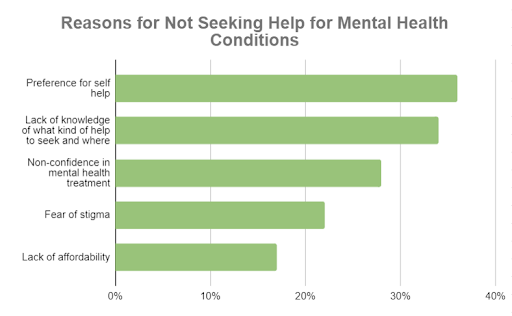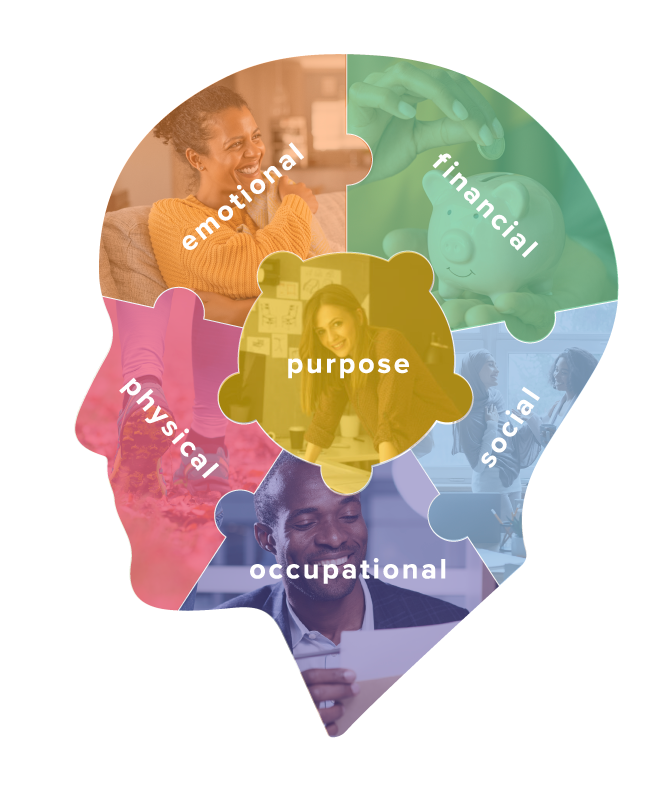During the COVID-19 pandemic, people spent a lot of time isolated and indoors, which helped foster an environment where some people now feel lonelier than ever. The result is a loss of social connectedness—the degree to which people feel the social connections and relationships in their lives to satisfy their wants and needs. When social…
Your Welcoa membership has expired.
Solving for EX: How Holistic Approaches to Mental Health Can Improve Employee Experience
While hybrid work models and bumps in pay have proven to be positive outcomes of the pandemic, employees are still increasingly unhappy in their current roles.
According to the U.S. Department of Labor, 4.4 million Americans left their jobs in February 2022, with nearly 75 percent citing a lack of confidence in their employer’s prioritization of their well-being as the main reason for leaving.
So if providing accommodations like hybrid work options and increased pay isn’t enough for employers to satisfy and retain workers and show their commitment to well-being, what are they missing and what can they do about it?
Finding the Missing Variable
In the first few months of quarantine, Gallup found that the number of employees who felt that their employers cared about their well-being shot up to 49 percent. What no one foresaw, however, was the mental, emotional, and financial impact felt by workers as the state of the world grew increasingly uncertain.
While sentiments towards employee well-being were overwhelmingly positive in the spring of 2020, the number of workers who feel supported by their organizations has since dropped to 24 percent in 2022—the lowest in almost a decade.
A significant driver of this was a perceived lack of support for mental health. Even before the pandemic, the mental health of America’s workforce had never been an easy equation to solve. According to the Kaiser Family Foundation, one in ten adults reported major symptoms of anxiety and depression in 2019, with 24.7 percent reporting an inability to find sufficient treatment. The pandemic only exacerbated these issues.
As a result, increasing numbers of employees are uprooting and moving to new places of employment due to a lack of emotional support from their employers.
The State of Employee Mental Health in 2022
As workplaces continue to evolve based on market trends and economic ebbs and flows, so do employee expectations about work.
Employees experienced a spike in stress, worry, anger, and sadness in 2020 and 2021. Based on data from the National Institute of Mental Health, one in five adults (roughly 52.9 million individuals) are currently living with some form of mental illness.
Over half of those individuals currently living with AMI (Any Mental Illness) are aged between 18 and 49, which consists of a majority of America’s workforce. Even more significant is the prevalence of AMI in adults of two or more races, with almost 31.7 percent currently reporting major symptoms of anxiety and depression.
Employer medical claims likely miss more than 75 percent of reported employee mental health issues, due to individuals refusing or not knowing how to seek help, overpriced treatment options, and a fear of stigma from their managers.

Source: Sapien Labs, The Mental Health Million Project
After two years of fluctuating between at-home and in-person work, employees everywhere feel uncomfortable and unmotivated to return to the office full-time. Thus, when onsite working schedules are mandated, workers feel less motivated to participate in company events and connect with their environment, leading to increased absenteeism and turnover, decreased productivity, and reduced morale.
On the other hand, according to Microsoft’s “New Future of Work 2022” report, while remote work and job autonomy can improve morale, employees may also feel socially isolated and emotionally exhausted due to a lack of organizational support. When employees can’t establish meaningful connections with their colleagues, they can experience greater emotional and work-related exhaustion, which often leads to lower levels of engagement.
Employees Are Our Guides to Corporate Wellness
When it comes to seeking help for mental health conditions, employees would rather manage their symptoms on their own than risk potential backlash. With coverage for treatment not nearly as comprehensive as options for physical ailments, it’s not surprising that mental health is often put on the backburner, explaining why employee burnout is the highest it’s been in years.
As workers slowly become stakeholders in business operations and outcomes, companies will need to consider workplace wellness at large, and employee mental health is a key part of that. It has now become a table-stakes issue for employers struggling to engage and retain an increasingly burned-out workforce.
– Mercer 2022 Global Talent Trends Study
As we move into a new era of work, it’s clear that employers must infuse their wellness programs with holistic offerings that meet the needs of the whole person. That includes addressing physical, mental/emotional, financial, social, occupational, and purpose-driven well-being at an individual rather than an organizational level.

Source: WellRight
Moving beyond biometric screenings and traditional one-size-fits-all wellness approaches starts with evolving mental health initiatives into dynamic offerings that meet employees where they are on their wellness journeys.
To get a pulse on what employees need most, employers can design programming around the social determinants of health (SDOH) that influence mental health at an individual level. By establishing employee resource groups (ERGs), employers can quantifiably gather honest feedback and use it to inform wellness initiatives and program strategy.
4 Ways Workplace Wellness Models Can Solve the Employee Mental Health Crisis
With over 39 percent of employees claiming that a climate of human-centric leadership and trust is a top requirement in job selection, the impetus is now on employers to foster a culture of empathy through their wellness programs and beyond. But while employers can find helpful resources to bridge gaps in care, getting employees to take advantage of them is easier said than done.
The task for employers is to evaluate which aspects of their wellness programs need to be modified to motivate burned-out employees to use available resources. That starts, first and foremost, by determining how mental health is addressed and where personalized, holistic touches can be infused.
Break Stigma by Being Relatable
It doesn’t take much to notice when an employee has the flu. However, it’s more challenging to know when someone is suffering from anxiety or depression, especially when they’re hiding it out of fear of judgment.
To honor every employee’s willingness to share how they’re doing, employers must create psychologically safe workplaces rooted in inclusivity and empathy.
– Mercer 2022 Global Talent Trends Study
Promoting a culture of empathy disassembles barriers that prevent employees from confiding in their employers. Approaching mental health from an equitable standpoint can prevent common conditions from being stigmatized and pave the way for normalization.
By imbuing programming and communications with relatable digital mental health solutions that reach employees wherever they are on their wellness journey, employers can be proactive rather than reactive in treating work-related stress and burnout.
Personalize Holistic Wellness
When wellness programs are personalized to mirror each employee’s unique needs, they transform from stand-alone benefits packages into extended wellness profiles.
– Vanessa Guzman, CEO, SmartRise Health
When Mercer asked employees to describe the future of work in its 2022 Global Talent Trends survey, one in three said the main focus will be on equity and whole-person wellness outcomes as opposed to benefits. As a result, HR leaders are taking note, with 85 percent recognizing the need for hyper-personalization to ensure their benefits attract and retain talent.
By tailoring offerings around wellness outcomes and listening to what all employees value from an individual standpoint, employers can better support aspects of wellness that often fall through the cracks, but that also heavily impact productivity and morale.
Make Programming Flexible
Developing holistic wellness initiatives that leverage mental health is one thing, but designing and implementing them for an entire workforce is another.
As organizations commit to offering expanded wellness solutions that highlight mental health, they must carefully vet resources, vendors, and benefits to find the right mix that aligns with the needs of their employees. Capturing data and reviewing reports enables program managers to analyze data by user segments and get a comprehensive picture of program effectiveness.
But the true signifier of a meaningful wellness program implementation? Flexibility.
Authentic wellness initiatives evolve as the world changes and as employees progress through their wellness journeys. A recent McKinsey study revealed that two-thirds of employees currently view flexible work schedules and hybrid models as essential workplace policies to alleviate stress, so it’s important to implement wellness programming that enables employees to decide where and how they want to work.
In doing so, organizations can actually boost engagement in their wellness programs and see a valuable return on their program investments.
Ensure Easy Accessibility
A flexible wellness program can only go so far without the proper infrastructure to back it up. Because employee needs continue to change, the availability and accessibility of program services will need to change with them.
Take teletherapy, for example. Three years ago, offering access to virtual therapy and telemedicine was seen as a perk by employees. Today, it’s table stakes, with 40 percent of consumers saying they will continue to use telehealth services well into the future.
In order to thoughtfully accommodate each area of an employee’s well-being, it’s vital that wellness programs seamlessly integrate with point solutions so workers can access the resources they need, where they need them. In regards to mental health, digital solutions and SMS-based counseling that can be accessed at any time are particularly effective at ensuring anonymity, eliminating stigma, and providing tailored support.
EX = Stigma-Free Mental Health Support
Solving for employee experience doesn’t only consist of providing helpful resources and custom wellness initiatives. Creating a culture of empathy and proactive support will eliminate stigma and build long-lasting trust between employees and employers.
WellRight has the expertise and resources to help companies design holistic wellness programs, challenges, and other services that support the mental health of workforces. To learn more about how we work with companies like yours, contact us today.

WellRight
WellRight’s powerful corporate wellness platform offers a unique approach that makes it easy to create healthy habits that last, so your employees can become the best versions of themselves.
WellRight was a 2022 WELCOA Summit Sponsor and are a proud partner of the WELCOA Premier Provider Network. To learn more visit their Vendor Profile.




